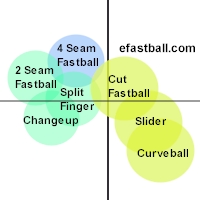
How to Grip a Four Seam Fastball
Updates:
- 5/08 - Initial page



4 Seam Fastball

Right Handed Pitcher
AKA
This grip is usually called either a rising fastball or just a fastball. It is also called cross-seam fastball, heater, cheese, hummer and smoke or smoker.Position the Ball
Cross seams. Turn the ball where the horseshoes (the "U") run sideways. The closed part of the horseshoe points to your thumb and the open part points to the pinky.Position your fingers
Place your first and second (index and middle) fingers over the cross seam.Position your thumb
Place your thumb directly under the ball on the smooth part of the baseball (no seam).Exert Pressure
Get a good grip on the seams with your finger pads.Squeeze the ball with your thumb pushing against your index and middle fingers.
Delivery and Release
Push your middle finger toward the batter. Your hand will pronate (thumb down, inward, clockwise LH, counterclockwise RH) slightly.This is the opposite rotation of a curveball.
Compared to other grips
This is the fastest pitch because the ball has four seams cutting against the air.This pitch can be delivered with the most accuracy since it has very little sideways or up/down movement.
This is also a dangerous pitch if pitched below the top of the zone since the ball goes straight.
What the hitter sees
This ball appears to rise. The four-seam fastball is often mislabeled a rising fastball.The hitter experiences an optical illusion because he expects the ball to drop 4-5 inches like a 2 seamer but it stays up longer than other pitches (drops only 2-3 inches).
The seams (and the entire ball) appear to the hitter as a pink blur since the seams are rotating from bottom to top.
Alternate grip
Rotate the ball to the next seam, so the closed part of the horseshoe points to your pinky and the open part points to the thumb.When to throw
After the 2 seamer, this is the most common pitch thrown in baseball. Some type of fastball is thrown 60% of the time in the majors.The 4 seamer is the easiest pitch to locate.
It is also the most common pitch to throw up in the strike zone since the batter will tend to swing under it, resulting in a popup.
Since this pitch has the least movement, do not throw this around the middle of the strike zone unless you are throwing some serious heat.
What it does (movement)
The ball creates a tight spin and rotates from bottom-to-top as viewed by the hitter.4 seamers have very little noticeable movement up/down or sideways. The ball will move down and to the right for a right handed pitcher. For a left hand pitcher, it moves down and to the left.
Four seamers typically drop only 2-3 inches from a straight line on release.
Reaction Time
The hitter has roughly 0.40 seconds to hit this pitch.Typical Speed
This pitch is the fastest pitch of all.| 10 and under | 40-50 mph |
| 11-12 | 50-60 mph |
| 13-14 | 55-75 mph |
| High School | 75-85 mph |
| College/ Pro | 80-95 mph |
The average speed of a fastball is 91mph in the majors.
The ball will typically slow down 8-10 mph by the time it reaches the front of the plate. (Note that your home radar gun may stop reading well before the ball reaches the plate because the hitter is in the way.)
